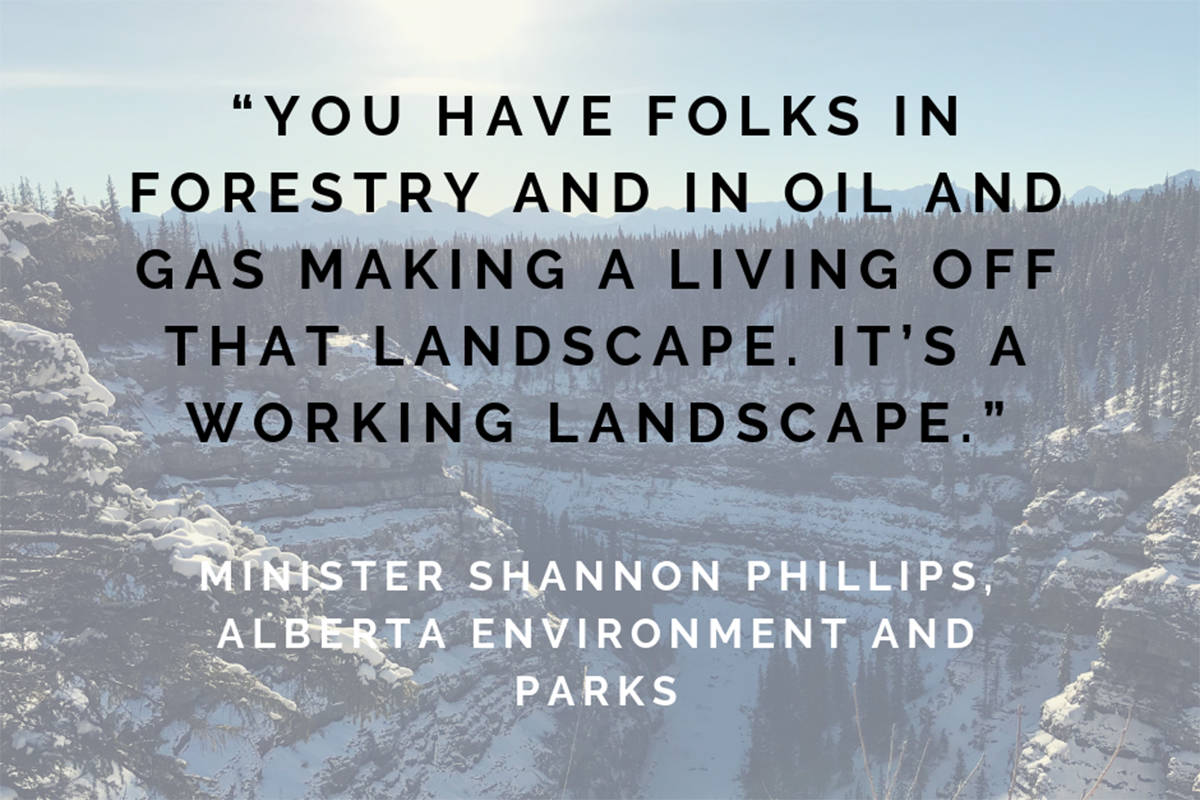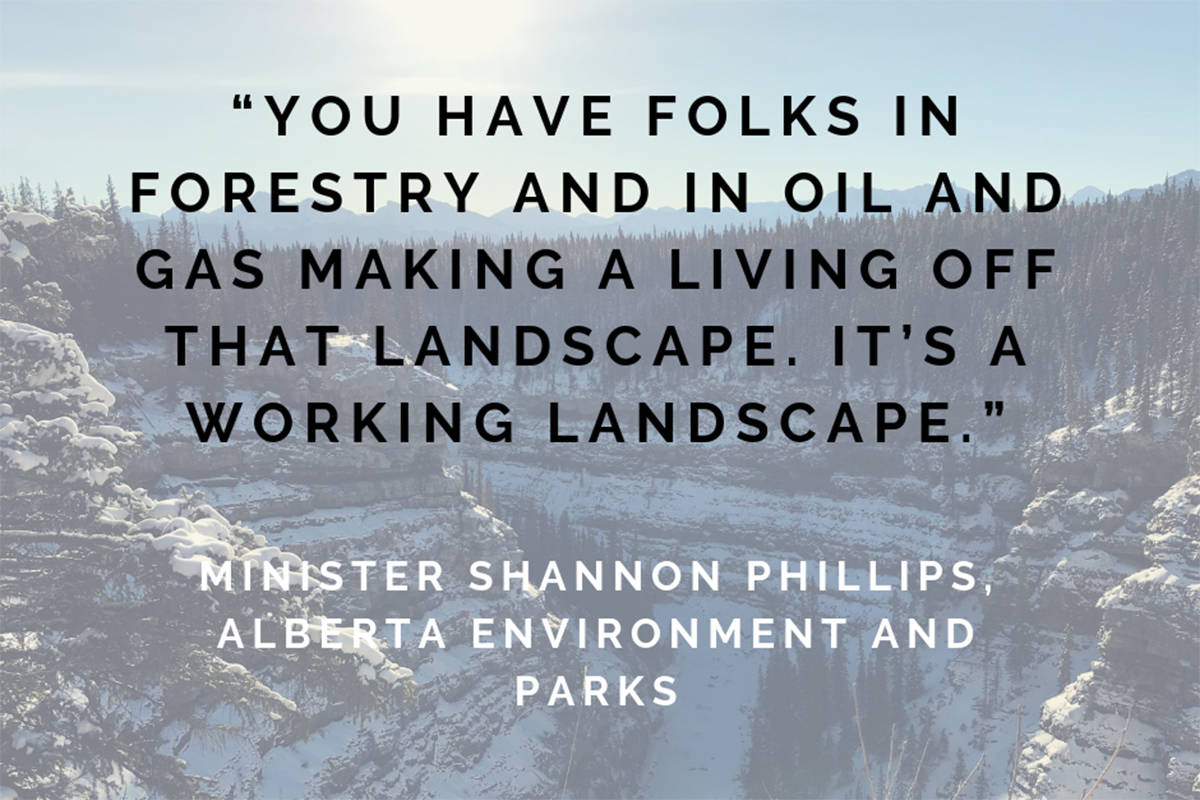The desire to see changes in the Bighorn Country has being going on for a lot longer than most people realize.
That was one of the key messages from Minister Shannon Phillips, of Alberta Environment and Parks, during one of several telephone town halls.
Held Jan. 16 for the Red Deer area, the hour long town hall was intended to clarify misconceptions about the proposal and to also hear from Albertans their concerns.
Phillips started by pointing out that the $40 million, five-year proposal, is aimed at balancing out the needs of industry, recreation and the ecosystem of the area while also managing population growth.
“Over a million people have moved to Alberta in the last decade, and as more and more people discover the Bighorn area, we’re seeing pressures mount on the landscape,” said Phillips in her preamble.
“Those pressures are reaching a tipping point, and we’re running the risk of losing the very things that make Bighorn special and why so many people care so deeply about it.”
She clarified that recent postponements of public sessions were due to concern for the public safety, but added that those meetings are still being planned for.
Read More: MLAs Ron Orr and Jason Nixon comment on Bighorn Country consultations
Read More: Alberta proposes $40 million investment into Bighorn Country over five years
Phillips also tackled what she calls misinformation on social media. “First, this proposal would mean no changes whatsoever to designated OHV (off-highway vehicles) trails in the provincial and wild land parks.”
“Some of our $40 million proposed investment is to improve existing trails and support the local user groups that have been doing this work for decades without government support,” she explained.
Plus, the industries of forestry and oil and gas would see no change.
Click here to share your views in the Bighorn area.
Questions from listeners, using their first names only, related to many concerns Albertans have, from hunting, to grazing, to industry and recreational use.
Bill posed a question about hunting and if it would be affected by the proposal, to which Phillips replied that it wouldn’t.
“Hunting (and fishing) is part conservation right? It’s about managing wildlife on the landscape and it’s an integral part of making sure that the nature that we all want to get outside and connect to is there for future generations.”
An issue that appears to be a big concern is over industry and its future. The minister pointed out that the proposed public land-use zone does not apply to forestry and oil and gas and that they fall under a completely different set of regulations.
When it comes to grazing rights, Phillips praised Alberta’s ranchers pointing out how staunch ranchers are in their grazing commitments.
“I’m astonished at the level of responsibility of grazing leaseholders,” said Phillips. “Almost no one colours outside the line.”
She did point out that there are many different uses in the 400,000 hectare area.
The proposal looks at hiking, backcountry camping, some possibility for staging areas for cross country skiing and snowmobiling. “The further east out you get, you get more existing industrial development.”
Hence the reason for the proposal.
“You have folks in forestry and in oil and gas making a living off that landscape. It’s a working landscape,” explained Phillips.
Plans for the Bighorn Country have actually been going on for quite some time now. Indeed, Lacombe-Ponoka MLA Ron Orr has stated that the United Conservative Party would most-likely review the area.
A caller named Brandon questioned the need for working with a group called Y2Y (Yellowstone To Yukon Conservation Initiative).
Phillips pointed out that the province looked at older plans for the area such as a Clearwater County plan from 1992. Plus the proposal committee looked at a regional council advisory from 2014, plus looked at letters from the Clearwater Trails Initiative.
“I’m not interested in listening to Justin Trudeau tell us what to do in Ottawa, neither am I interested in being told what to do by specific special interest groups,” she stated. “What I’m interested in is your advice. Albertans’ advice.”
For OHVs there will be some investment in staging areas, bridges and hardening of roads. Horseback riding will also remain open.
“I want to provide those assurances, because that’s really important to me that existing small business owners are still able to make a living on the landscape,” she said of horseback trails.
For those who like random camping, Phillips said they would remain and while it’s called random or rustic camping, many families go to the same area year after year.
“We’ve given the supports for things like fire rings and pit toilets, where we can, and garbage disposal, where we can,” said Phillips.
She did say that camping is allowed for 14 days (something that is currently law), which is why a permitting process is proposed, “…so that we know that they aren’t overstaying their welcome and wrecking it for everyone else.”
Phillips also added that the province is not investing in hotels. However, it proposes spending money to improve current campsites and adding some loops. Some sites haven’t been touched since the 1980s.
She said Alberta’s parks are rated as ‘poor’, and investment into the parks is expected to bring them up to “fair”.
“What government would invest in are things like refurbishing our campground loops. Making sure we’ve got functioning toilets and garbage disposal system,” said Phillips.
A large part of the $40 million would go into operations by re-opening the Nordegg Ranger Station and bringing additional enforcement to deal with river riders.
She added that Kananaskis has one hotel for a “massive area” and suggested that existing municipalities such as Sundre, Rocky Mountain House and Nordegg may be able to see some growth to its tax base with small businesses bringing tourism activities.
Phillips suggests this would also allow some municipalities to diversify their economies, which would help during economic downturns.
Officials say there were 3,400 people on the phone line, plus Albertans had a chance to pose questions online. bout 35,000 people have shared input into the proposal.
jeff.heyden-kaye@ponokanews.com
Like us on Facebook and follow us on Twitter




